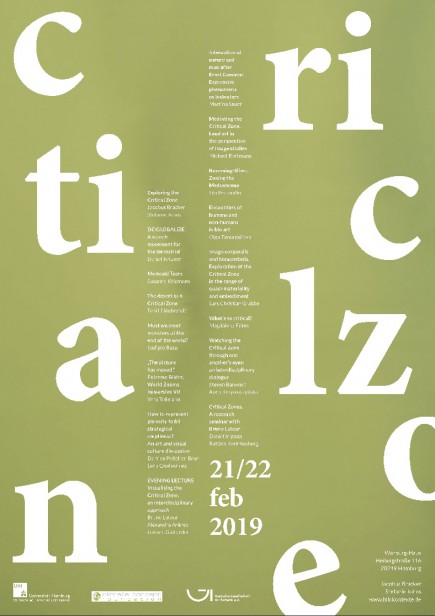Critical Zone
A trans- and interdisciplinary conference at the University of Hamburg
Warburg-Haus Hamburg, Heilwigstraße 116, 20249 Hamburg, Germany
21.02.2019, 12:00 Uhr bis 22.02.2019, 18:00 Uhr

A trans- and interdisciplinary conference at the University of Hamburg
Whilst, led by obvious geo- and biopolitical interests, a fierce fight over the existence and dimension of human-made climate change is taking place in the political arena, earth is acting unimpressed. Nevertheless, events like droughts, floodings, famines, melting glaciers and the extinction of species are striking us so directly that it seems impossible to clutch at the distancing dichotomy of nature and culture. Based on the measurable and visible extent of human impact on earth geo sciences already discuss a new geological era: the anthropocene. However, its epistemes – like those of other sciences and humanities – seem disposable. Instead of pursuing dichotomous world views or despairingly taking the escape route of climate change denial into an imagined parallel world, Bruno Latour (2017, 2018) proposes to set out for the ‘critical zone’. The ‘critical zone’ is the thin near-surface layer of earth between the bottom of the groundwater and the tops of the trees. Ther e, rock, soil, water, air, and living organisms constantly interact and constitute through highly complex transformational processes the conditions for all terrestrial life. In this zone earth displays its agency relevant to humans. Now it is essential to explore this new territory to understand the inseparable interweaving of humans and terrestrial processes.
Such an exploration raises questions of visibility and display. Therefore, the conference undertakes an image-theoretical expedition into the critical zone to collect evidence to answer the following questions:
– What are the living conditions for images in the critical zone?
– Can images be understood as mediators between earth and humans or as agents within the critical zone?
– Which image strategies arise to stage the new political actant ‘earth’?
– Do there exist other animalia symbolica (Cassirer) next to humans in the critical zone?
– How are conditions of visibility in the critical zone configured for its figurative symptoms?
– How do images form/educate within the critical zone? Ho do they (de-)construct world views?
– How are images involved in the transformation of knowledge on climate change?
– How does artistic practice articulate these questions, i.a. as critical pointing gestures and transforming creators?
PROGRAMME
/// Thursday, 21. February 2019 ///
12.00 Welcome
12.30 Exploring the Critical Zone. Jacobus Bracker, Hamburg // Stefanie Johns, Hamburg
13.00 DE\GLOBALIZE. A search movement for the terrestrial
Daniel Fetzner, Offenburg
13.40 Mermaid Tears
Susanne Kriemann, Karlsruhe
14.40 The desert as a Critical Zone
Toni Hildebrandt, Bern
15.20 Must we meet monsters at the end of the world?
Sudipto Basu, Neu Delhi
16.20 „The picture has moved“. Extreme Bilder, World Zooms, Immersive VR
Vera Tollmann, Berlin
17.00 How to represent porosity to fill strategical emptiness? An art and visual culture discussion
Damien Pelletier-Brun, Rennes // Lena Quelvennec, Lund
18.00 Visualising the Critical Zone, an interdisciplinary approach
Bruno Latour, Paris // Alexandra Arènes, Manchester // Jérôme Gaillardet, Paris
19.00
Reception
/// Friday, 22. February 2019 ///
09.30 Moin moin
10.00 Interaction of nature and man after Ernst Cassirer: Expressive phenomena as indicators
Martina Sauer, Bühl (Baden)
10.40 Mediating the Critical Zone. Land art in the perspective of image studies
Michael Rottmann, Basel
11.40 Becoming-Slime. Zoning the Medusocene
Léa Perraudin, Köln
12.20 Encounters of humans and non-humans in bio art
Olga Timurgalieva, Warschau
14.00 Imago corporalis and homeostasis. Exploration of the Critical Zone in the range of quasi-materiality and embodiment
Lars Christian Grabbe, Münster
14.40 What’s so critical?
Magdalena Eckes, Stuttgart
15.40 Watching the Critical Zone through one another’s eyes: an interdisciplinary dialogue
Steven Banwart, Sheffield // Anna Krzywoszyńska, Sheffield
16.20
Critical Zones. A research seminar with Bruno Latour
Daniel Irrgang, Karlsruhe // Bettina Korintenberg, Karlsruhe
17.00 Farewell
ORGANISATION:
Jacobus Bracker (University of Hamburg, Institute for Archaeology and Cultural History of the Ancient Mediterranean)
Stefanie Johns (University of Hamburg, Faculty of Education, Art & Visual Education)
REGISTRATION: Attendance of the conference is free of any fees. However, due to limited space at the venue please register by email beforehand.
post@nullbildkontexte.de
Generously supported by the University of Hamburg, the Climate Concept Foundation, and Deutsche Gesellschaft für Ästhetik e.V.
Be part of it!
